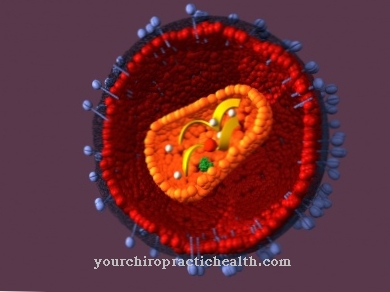The Hyperlipoproteinemia (HLP) is characterized by increased levels of cholesterol, triglycerides and lipoproteins in the blood. The causes of hyperlipoproteinemia are diverse and its consequences must be considered in a differentiated manner.
What is hyperlipoproteinemia?

© beawolf - stock.adobe.com
The Hyperlipoproteinemia is a lipid metabolism disorder that has either primary or secondary causes. Primary hyperlipoproteinemia is genetic, while the secondary form is always a consequence of an unhealthy lifestyle or underlying diseases, such as B. diabetes.
Lipoproteins are constantly in the blood because they have a transport function for cholesterol and triglycerides (fats). The cholesterol formed during lipid metabolism takes on central functions in the organism. It is the starting material for the steroid hormones, the bile, and is a main component of all cell membranes. The triglycerides must also be brought to their destination for energy production. The lipoproteins transport the lipids either from the liver to the other organs using LDL (low density lipoproteins) or vice versa from the organs and blood vessel system to the liver using HDL (higher density lipoproteins).
In hyperlipoproteinemia, the ratio of LDL to HDL is often shifted in favor of LDL. However, LDL has a great risk potential for arteriosclerosis and the diseases resulting from it. HDL has the opposite effect. Hyperlipoproteinemia is also divided into hypercholesterolaemia (increased cholesterol levels), hypertriglyceridaemia (increased triglyceride levels) and mixed hyperlipidaemia.
causes
The Hyperlipoproteinemia is genetically determined in its primary form. There are many mutation possibilities on the lipoproteins. The regulating mechanism of the process of reducing and building up cholesterol can also be disturbed.
As a result, hyperlipoproteinemias of the most varied types occur with different risks for secondary diseases. Secondly, they usually arise from a high-fat diet, lack of exercise or as a result of underlying diseases that are related to fat metabolism, such as B. diabetes, obesity, liver or biliary diseases. Type 2 diabetes is e.g. B. characterized in that very high concentrations of the same must be formed due to the poorly effective insulin. However, since insulin also mobilizes fat, the lipid concentration in the blood increases.
Fats and cholesterol are lipids and are therefore always transported together by lipoproteins. Diseases that lead to the disruption of fat loss are also the cause of hyperlipoproteinemia, such as increased fat intake through food, reduced fat loss due to lack of exercise or increased fat release from fat cells in the case of obesity.
Symptoms, ailments & signs
There are several forms of hyperlipoproteinemia. They differ in terms of their symptoms. A prominent symptom that can indicate all forms of the disease is the appearance of tendinous xanthomas. These are small yellowish-white skin changes. There are five types of primary hyperlipoproteinemia with different symptoms.
Type 1 is primarily indicated by xanthomas and lipid deposits in the liver and spleen.Type 2 leads to circulatory disorders, arteriosclerosis and an increased cholesterol level. This type of disease is associated with an increased risk of heart attack. Even with type 3, the cholesterol level is increased and the risk of arteriosclerosis is increased.
The most distinctive symptoms of type 4 are abdominal pain in the form of upper abdominal colic, obesity, fatty liver, hyperuricemia (gout), an increased risk of arteriosclerosis and frequent inflammation of the pancreas (pancreatitis). Type 5 is characterized by simultaneous enlargement of the spleen and liver (hepatosplenomegaly).
It also leads to xanthomas of the skin, epigastric colic, obesity and high cholesterol levels. There is also secondary hyperlipoproteinemia, which, in addition to tendinous xanthomas, can also be indicated by so-called xanthelasma in a few cases. These are noticeable symmetrical yellowish-white skin changes on the eyelids and the inner corner of the eye.
Diagnosis & course
A Hyperlipoproteinemia is primarily symptom-free. However, it can be the cause of serious cardiovascular diseases, which can lead to heart attacks or strokes.
Certain forms of hyperlipoproteinemia can namely form plaques in the blood vessels (arteriosclerosis), which then cause these diseases. There is only an increased risk of arteriosclerosis with increased LDL or decreased HDL. HDL transports the lipids from the blood vessel system to the liver. It also partially dissolves cholesterol from the plaques so that they can shrink. However, the LDL cholesterol is transported from the liver to the organs.
It is easily oxidized and, in its oxidized form, is quickly absorbed by macrophages, which then attach to the plaques as fat-laden foam cells. The diagnosis of hyperlipoproteinemia is made by determining the blood lipid values of total cholesterol, triglycerides, LDL cholesterol, HDL cholesterol and lipoproteins after a food abstinence of at least 12 hours.
Complications
Hyperlipoproteinemia causes various complaints and symptoms in the patient. These symptoms usually depend on the exact type of hyperlipoproteinemia. Typically, patients are obese and continue to be overweight. There is an increased risk of a heart attack, as a result of which the life expectancy of the patient is usually greatly reduced.
It is not uncommon for abdominal pain to occur. The liver can also be affected by hyperlipoproteinemia from fatty liver. Being overweight itself has a very negative effect on the general health of the patient and can lead to further pain in the joints and knees of the person concerned.
There are other cardiovascular diseases caused by hyperlipoproteinemia. Should a stroke occur, it can lead to death or severe restrictions in the everyday life of the person affected. Above all, paralysis occurs, which can complicate everyday life.
Treatment of hyperlipoproteinemia does not lead to further complications. In most cases, it takes place with the help of drugs that limit the symptoms. However, the person concerned should lead a healthy lifestyle and avoid being overweight in any case. There may be a reduction in life expectancy.
When should you go to the doctor?
If symptoms such as abdominal pain, obesity, circulatory disorders, or signs of fatty liver are noticed, the underlying condition may be hyperlipoproteinemia. A visit to the doctor is indicated if the symptoms persist for several days and severely impair well-being. If there are any further problems, it is best to see a doctor on the same day. The disease can be treated well if it is recognized early. In the absence of treatment, however, serious complications and long-term effects can develop.
Medical advice is required at the latest when signs of arteriosclerosis or other serious illnesses are noticed. The person concerned should visit the family doctor immediately and arrange for further examinations. People who lead unhealthy lifestyles are particularly prone to developing hyperlipoproteinemia. Obesity, liver or biliary diseases and type 2 diabetes are typical risk factors that need to be clarified. If the symptoms mentioned occur in connection with these diseases, an immediate clarification by the family doctor or an internist is indicated.
Doctors & therapists in your area
Treatment & Therapy
The Hyperlipoproteinemia is in need of treatment due to its risk of developing arteriosclerosis. Primary hyperlipoproteinemia requires constant drug treatment. So-called lipid lowering agents are applied for this purpose.
Important lipid lowering agents include CSE inhibitors, niacin and fibrates. In the secondary forms of this metabolic disorder, a change in lifestyle is often enough. Obesity should be reduced through a low-fat, low-calorie, high-fiber diet. If another disease is the cause, treating it is a prerequisite for achieving normal blood lipid levels.
Since hyperlipoproteinemia is only a symptom but not an independent disease, it can only be considered in the overall complex of therapy.
Outlook & forecast
Hyperlipoproteinemia is not cured in most cases. Nevertheless, the prognosis is linked to the underlying disease and must be assessed individually. In the case of a chronic illness, the symptoms that arise are treated. No cure is indicated for diabetes, but a good quality of life can be achieved if various guidelines are taken into account.
The administration of medication regulates the metabolism, which leads to an improvement in the symptoms. In long-term therapy, successful symptom relief can therefore be documented in a large number of patients. However, a relapse occurs immediately if the medication is discontinued or if there are no necessary check-ups in which the active ingredients are readjusted.
If hyperlipoproteinemia is triggered by being very overweight, the patient has a good prognosis if there is a permanent loss of weight. The healing of the underlying disease takes time and is often associated with relapses or other complications. Nevertheless, there is a prospect of improvement. With a lack of exercise and a poor diet, the person affected can in some cases independently contribute to an improvement in their quality of life.
If the organs are damaged, long-term therapy is also necessary. In some cases, an organ donation must be performed. If this takes place successfully, the hyperlipoproteinemia is considered cured.
prevention
The secondary forms of Hyperlipoproteinemia can be prevented well. A healthy lifestyle without nicotine, a healthy diet and sufficient exercise are sufficient. Some pre-existing conditions of hyperlipoproteinemia can also be prevented in this way.
Aftercare
In the case of hyperlipoproteinemia, the early detection and treatment of the disease is in the foreground. A doctor should be contacted at the first symptoms and complaints. In most cases, the earlier the disease is recognized, the better the further course of hyperlipoproteinemia. Since this cannot lead to self-healing, a medical examination and treatment must always take place.
The disease is usually treated by taking medication. It is important to ensure the correct dosage with regular intake so that the symptoms can be properly alleviated. In the event of side effects or interactions with other medications, a doctor should always be consulted first.
In general, with hyperlipoproteinemia, a healthy lifestyle with a proper diet also has a positive effect on the course of the disease. Obesity should be avoided. Regular examinations by a doctor are also very useful, whereby the fat levels in the blood should be checked in particular. In some cases, hyperlipoproteinemia has another underlying condition that needs primary treatment. The disease may lead to a reduced life expectancy for the person affected.
You can do that yourself
A change in diet can make a significant contribution to reducing blood lipid levels and body weight in hyperlipoproteinemia. The daily fat intake should be limited to a maximum of 30 percent of the daily calorie intake, including hidden fats. Vegetable oils consisting of unsaturated fatty acids are recommended for the preparation of the dishes; the use of chemically hydrogenated fats is not advisable. Cold water fish such as salmon or mackerel contain valuable omega-3 fatty acids, which can have a beneficial effect on the cholesterol level. Gentle cooking methods such as stewing or steaming can do without any fat. About half of the daily calorie requirement should be covered by complex carbohydrates from fruits, vegetables, whole grains, potatoes and legumes. Garlic, artichoke leaves and psyllium are said to have a cholesterol-lowering and vascular protective effect.
Lots of exercise and a healthy lifestyle with little alcohol and if possible without nicotine help to reduce excess weight and thereby improve blood lipid levels. In addition, the risk of developing cardiovascular disease as a result of hyperlipoproteinemia is reduced. Existing underlying diseases such as diabetes mellitus must be treated and adjusted as best as possible. If there is a family history, regular monitoring of blood lipid levels is recommended in order to be able to counteract an increase before damage to health occurs. In the case of hereditary hyperlipoproteinemia, drug therapy is usually necessary in addition to changing lifestyle.



.jpg)

.jpg)
.jpg)






.jpg)

.jpg)
.jpg)











.jpg)